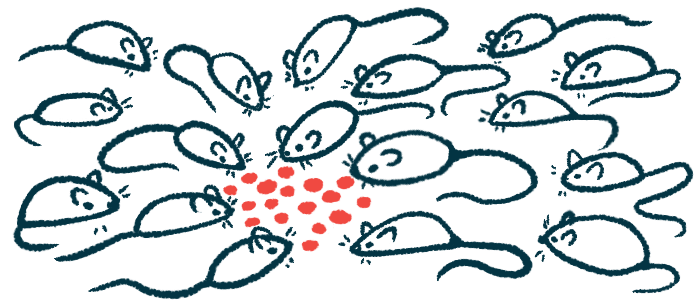Early data support Regenxbio’s gene therapy program for CLN2 disease
Gene therapy seen to ease signs, symptoms of late infantile Batten in mice
Written by |

Gene therapy was able to reduce the signs and symptoms of late infantile Batten disease in a mouse model carrying a common disease-causing mutation, a study shows.
These findings support Regenxbio’s ongoing gene therapy program, which includes RGX-181, currently being tested as part of a single-patient study in Brazil. In the U.S., its development has been delayed by the Food and Drug Administration, which cited the need for more information about dose selection and study procedures.
The mouse study, “Gene therapy ameliorates spontaneous seizures associated with cortical neuron loss in a Cln2R207X mouse model,” was published in The Journal of Clinical Investigation.
Need for less-invasive and more effective treatments for CLN2 disease
Most cases of late infantile Batten, also called CLN2 disease, are caused by mutations in the gene that encodes an enzyme called TPP1.
Found in the cell’s recycling centers called lysosomes, these mutations lead to a TPP1 deficiency. As a result, cellular waste builds up to toxic levels, killing cells, especially nerve cells, and triggering the onset of neurological symptoms.
Signs of the condition usually appear between 2 and 4 years of age, and include vision loss, seizures, muscle twitches, difficulties walking and maintaining balance (ataxia), and cognitive and speech delays.
The only currently approved treatment is enzyme replacement therapy, which provides a lab-made version of TPP1. Although enzyme replacement therapy can slow the progressive loss of walking abilities, it is administered once every other week by infusion directly into the fluid surrounding the brain.
“Therefore, there is still a need to develop less invasive and more effective therapies for CLN2 disease,” the researchers wrote.
Regenxbio is developing RGX-181, a gene therapy designed to increase TPP1 levels in the brain and spinal cord.
RGX-181’s clinical delay has also stopped the RGX-381 program, the company’s investigational gene therapy for vision impairment associated with CLN2. Regenxbio stated its first-in-human Phase 1/2 clinical trial of RGX-381 is on track to begin in the first half of this year.
Study tested mice carrying common human disease-causing mutation
In the preclinical study, scientists at Regenxbio, collaborating with researchers at Washington University in St. Louis, Missouri, tested gene therapy on mice carrying one of the most common human disease-causing mutations called Cln2-R207X. The study was funded, in part, by Regenxbio.
First, the team examined the effects of this mutation on mice without treatment to provide a comparison to assess the effectiveness of the gene therapy.
Long-term electroencephalography recordings, which measured the electrical activity in the brain, showed progressive abnormalities beginning at three months of age. Changes in brain activity were accompanied by spontaneous seizures in 90% of mutant mice, with 70% dying within three minutes of their last seizure.
At four months, mutant mice showed gait defects, including a significantly shorter stride length and swing duration, on average, and more time on three and four feet, which suggested “late onset of locomotor deficits,” the team wrote.
The seizures and gait defects were explained by a significant loss of neurons (nerve cells) in the brain of CLN2 mice beginning at three months, which then progressed to the spinal cord after four months. Surviving neurons often appeared swollen with cellular waste material.
Also lost were GABAergic neurons, which release the neurotransmitter gamma-aminobutyric acid, or GABA, to regulate and suppress the activity of other neurons. Levels of GABA, and other neurotransmitters, such as glutamate and glutamine, were unaffected. Of note, neurotransmitters are chemical messengers that allow nerve cells to communicate.
Tissue staining showed a significant increase in cellular waste build-up in all brain and spinal cord regions at one month of age, with signs in most areas seen one day after birth.
Benefits of gene therapy seen in mice at three months
Further analysis found localized immune activation months before neuronal loss in the brain and spinal cord. This then progressed to astrogliosis, an abnormal increase in the number of neuron-supporting astrocytes due to the destruction of nearby neurons.
These findings were supported by evidence of a “distinct neuroinflammatory environment” in the brain and spine of the mutant mice, which was uniquely different from that seen in other Batten or neurodegenerative models, the researchers noted.
Finally, the researchers infused gene therapy into the brains of the mutant mice at one day of age, which provided a full version of the human gene delivered by a harmless and modified virus (AAV9.hCLN2). At three months, TPP1 activity in the brain and spinal cord increased up to 28-fold on average.
Gene therapy benefits included neuronal loss prevention, no cellular waste build-up, less immune activation, and fewer seizures. Treatment also restored a healthy gait in the mice by four months and significantly extended lifespan.
“These data provide a rationale for the subsequent clinical testing of AAV9.hCLN2 in CLN2 patients to determine its efficacy,” the researchers wrote. These findings also “highlight the importance of clinically relevant outcome measures for judging pre-clinical efficacy of therapeutic interventions for CLN2 disease.






